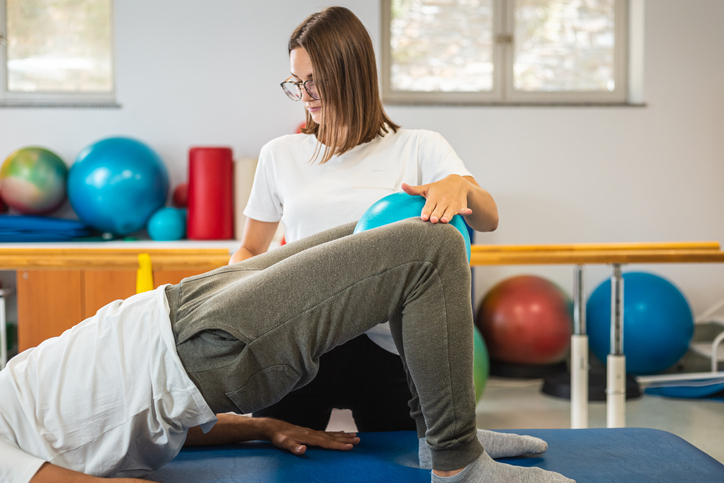The pelvic floor is a hammock-like structure of muscles that holds the pelvic organs in place. Sometimes, these muscles can become too tight or too loose, which can contribute to sexual health problems. Fortunately, pelvic floor physical therapy can help.
Often, women are the focus of pelvic floor physical therapy interventions, perhaps because pregnancy and childbirth can have a big impact the pelvic floor muscles. However, pelvic floor physical therapy may also be beneficial for men who are experiencing certain sexual dysfunctions.
Past studies have shown associations between pelvic floor dysfunction and male sexual dysfunctions including erectile dysfunction (ED), ejaculatory dysfunctions, and orgasmic disorders. Accordingly, training the pelvic floor muscles using appropriate physical therapy techniques may improve the sexual outcomes of men with pelvic floor dysfunction.
For example, research has shown that pelvic floor physical therapy can improve the rigidity and hardness of erections in some men. Even when such improvements are modest, they can make a big difference for patients emotionally and sexually. A small change may be the difference between a patient being able to have penetrative sex and not being able to do so.
Additionally, the pelvic floor plays a role in ejaculation, so training the pelvic floor muscles may give a man more control over this process. Men who struggle with premature ejaculation may be able to increase their intravaginal ejaculation latency time (i.e., the time from the start of vaginal penetration to ejaculation) with the help of pelvic floor physical therapy. (Up until now, most research on premature ejaculation has focused on intravaginal ejaculation latency time. Further research on ejaculation times during other forms of penetration could improve the data for all patients who engage in different types of sexual activities.)
Muscle contractions facilitated by the pelvic floor can enhance the pleasure and experience of orgasm. Therefore, doing appropriate pelvic floor exercises may intensify the feelings of pleasure that a person has during orgasm or ejaculation.
Recently, pelvic floor physical therapy has been explored as a treatment option for Peyronie’s disease. Some physical therapists utilize pelvic floor exercises, manual therapy, hip stretching/mobility, neural modulation for balancing sympathetic/parasympathetic activity, and anxiety/stress management for patients who are suffering from Peyronie’s disease.
Lastly, men with chronic prostatitis/chronic pelvic pain syndrome (CP/CPPS) often experience difficulties and/or pain during sexual activity, bowel movements, and urination. This pain may be managed in part with a treatment plan that includes pelvic floor physical therapy techniques. Pelvic floor physical therapy can help to release tension in the pelvic floor muscles that may be causing painful sensations during these activities.
Depending on the circumstances, pelvic floor physical therapy may be beneficial for the sexual function of both men and women. As such, pelvic floor training exercises should be considered as part of a treatment approach (when appropriate) for patients who are experiencing sexual pain or a different type of sexual dysfunction.
References:
Cohen, D., Gonzalez, J., & Goldstein, I. (2016). The role of pelvic floor muscles in male sexual dysfunction and pelvic pain. Sexual Medicine Reviews, 4(1), 53-62. DOI: https://doi.org/10.1016/j.sxmr.2015.10.001
You may also be interested in...
Other Popular Articles

What Is the Average Penis Size?
If you have ever wondered how your penis compares to others in terms of size, you are not alone. Many men are curious to know how their penises stack up compared to the average. Unfortunately, general curiosity can sometimes give way to full-on obsession and anxiety about penis size. This can be an unhealthy and often unnecessary fixation, especially because most men who think their penises are too small have perfectly normal-sized penises.

What Is Jelqing, and Does It Actually Work?
The term “jelqing” refers to a set of penis stretching exercises that some believe can make the penis bigger. Although the practice has gained attention and popularity in blogs and internet forums in recent years, there is no scientific evidence that it is an effective way to permanently increase the size of one’s penis. In fact, in some cases, jelqing may actually cause damage to the penis, so it is a good idea to get all the facts before setting off to try it.

What Is Sensate Focus and How Does It Work?
Sensate focus is a technique used to improve intimacy and communication between partners around sex, reduce sexual performance anxiety, and shift away from ingrained, goal-oriented sexual patterns that may not be serving a couple.

Can Sex Reduce Menstrual Cramps?
The SMSNA periodically receives and publishes ‘guest editorials.’ The current article was submitted by Mia Barnes, a freelance writer and researcher who specializes in women's health, wellness, and healthy living. She is the Founder and Editor-in-Chief of Body+Mind Magazine.
Having sex while you experience menstrual cramps is healthy and can provide significant benefits. While it might not be the first activity that comes to mind when your PMS or period cramping begins, many people enjoy sex to reduce menstrual cramps, experience increased pleasure and benefit from other advantages. Learn more about having sex while menstrual cramps are happening and how it can help your body.

How Long Does It Take the Average Man to Ejaculate?
On average, it takes a man between 5 to 7 minutes to orgasm and ejaculate during sexual intercourse.

The Effect of Regular Aerobic Exercise on Erectile Function
Erectile dysfunction (ED) is the inability to achieve or maintain an erection sufficient for satisfactory sexual activity. As men get older, their erectile functioning may naturally decline due to changes in testosterone levels, cardiovascular functioning, and the potential development of other chronic medical conditions that become more common with age.
You are prohibited from using or uploading content you accessed through this website into external applications, bots, software, or websites, including those using artificial intelligence technologies and infrastructure, including deep learning, machine learning and large language models and generative AI.


